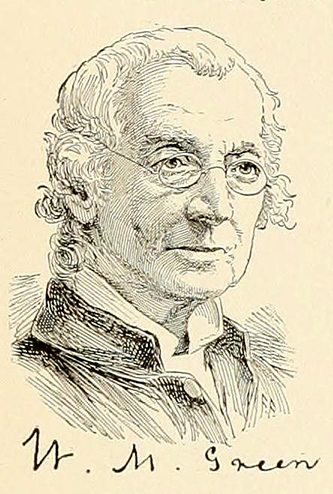2 May 1798–13 Feb. 1887

William Mercer Green, first Protestant Episcopal bishop of Mississippi, was born in Wilmington. His father was Lieutenant William Green, a patriot of the American Revolution, whose early death placed responsibility for his son's care upon his widow, Mary Bradley Green. His grandfather, Dr. Samuel Green, formerly of Liverpool, had left specific directions regarding the education of his progeny. With these ideas his Quaker mother was in complete accord. Her mother had been the former Elizabeth Sharpless, a birthright Quaker; her father, Richard Bradley, also a Friend, had come from Kendal, England. Young William Green was graduated from The University of North Carolina in 1818, yielding in honors only to his classmate and friend, James Knox Polk.
Greatly influenced by an account of Bishop George Berkeley's life, he turned to the study of theology. He valued the precepts of bishops John Henry Hobart and John Stark Ravenscroft, always calling himself "a Prayer Book churchman." On 29 Apr. 1821 Green received deacon's orders from Bishop Richard Channing Moore in Christ Church, Raleigh, and on 20 Apr. 1823 he was ordained a priest by Bishop Moore in St. James's Church, Wilmington. In the latter year he nominated the Diocese of North Carolina's first bishop, John Stark Ravenscroft. Green served first in St. John's Parish, Williamsborough, and then as rector of Emmanuel Church in Warrenton. In 1825 he went to St. Matthew's in Hillsborough, where he also directed the work of the Hillsborough Female Seminary. Two years later he returned to his alma mater as chaplain and professor of belles lettres. Dissatisfied that students had to attend college chapel services regardless of their denominational preference, he was determined to provide a place for Episcopalians to worship. His arduous labors resulted in his founding the Chapel of the Cross in Chapel Hill. Its completion was achieved on the eve of his being called to Mississippi as the state's first Protestant Episcopal bishop. There he was consecrated on 24 Feb. 1850 in St. Andrew's Church, Jackson. His responsibility included not only the care of the whole diocese but also, for two years, pastoral duties in Trinity Parish, Natchez. By his thirtieth year of active service in the diocese, the number of parishes had increased from ten to fifty-one; forty-one new churches had been built and the training of clergy fostered regardless of race. An assistant was not elected until the thirty-third year of his episcopate.
Green worked zealously to promote the establishment of training schools for clergy and was one of the founders of an institution, at Sewanee, Tenn., which he named the "University of the South." After becoming chancellor of that university in 1866, he built on its domain a residence that he called "Kendal" for his grandfather's home. Here he enjoyed the visits of his close friend and parishioner, Jefferson Davis. In North Carolina Green and his family had known the ravages of war, pestilence, and fire, which all fell to their lot again in Mississippi. After the tragic death of his son, the Reverend Duncan Cameron Green, during Greenville's yellow fever epidemic in 1878, the poet Longfellow wrote "The Chamber Over the Gate" and sent it with a letter of condolence to Bishop Green whom he had met.
In addition to his pastoral and diocesan work, Green was the author of Memoir of Bishop Ravenscroft (1830) and Memoir of the Rt. Rev. James Hervey Otey (1885). He received the D.D. degree from the University of Pennsylvania in 1845 and the LL.D. degree from The University of North Carolina in 1881.
On 22 Dec. 1818, he married Sally Williams Sneed of Williamsborough, N.C. Widowed in 1832, he married Charlotte Isabella Fleming of Pittsboro on 18 Dec. 1835. Of his thirteen children, several followed the clerical, medical, or professional vocations of their forefathers. After his death at his Sewanee home, Green was buried in Greenwood Cemetery, Jackson, Miss. He was succeeded by Hugh Miller Thompson, who had become his assistant in 1883. A portrait of Bishop Green was painted by Helen Frances Colburn of Washington City.